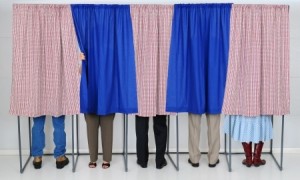On the Hill: Did Religious Voters Make a Big Difference in the Midterm Elections?
 Photo by scukrov / 123RF
Photo by scukrov / 123RF This year’s midterm elections were a tough one for progressive voters, as religious conservatives won seats in both the House and Senate. While the results may leave humanists and other secular Americans scratching their heads and wondering what went wrong, the Public Religion Research Institute (PRRI) just released a report that may help explain just what happened.
Last week I attended a PRRI event held at the Brookings Institution which focused on a recently released survey, the 2014 Post-Election American Values Survey. The report contained many interesting insights, such as how 53 percent of voters who are under forty years of age supported the Democratic candidate, while 56 percent of voters over sixty-five supported the Republican candidate. But I found the most interesting information to be that which dealt with the voting behaviors of the different religious and irreligious communities.
The American Values Survey seems to suggest that religious belief remains a strong predictor of political affiliation. White evangelical Protestant voters tend to vote conservatively, with 80 percent supporting the Republican candidate in their district while only 14 percent voted for the local Democrat. While this and most of the other religious voting behaviors weren’t a surprise, it was interesting to see that Catholics seemed to be split pretty much down the middle, with 46 percent supporting Democratic candidates and 47 percent supporting Republican candidates.
The numbers for the religiously unaffiliated were almost as extreme as those of white evangelical Protestants, but in support of the Democrats. Sixty-five percent of the religiously unaffiliated voted for the Democratic candidate, while only 24 percent voted for Republicans.
These numbers, while not necessarily unexpected, suggest that each party consistently attracts a sizeable but different part of the American religious community. The survey states that white evangelical Protestants make up 36 percent of Republican voters in 2014, which the survey calls “the single most important religious group in the GOP coalition.” Conversely, religiously unaffiliated voters make up 30 percent of Democratic voters.
On Election Day, white evangelical Protestants turned out to vote in huge numbers, which is one of the reasons why the Republicans cruised to victory. Perhaps a message to take away for Democrats would be that they need to inspire their likely voters by advocating policies which reinforce the separation of church and state, which would appeal to humanists and other religiously unaffiliated voters. The religiously unaffiliated are almost as significant a part of the Democratic coalition as religious conservatives are to the GOP coalition, but it certainly feels as though religious conservatives are being catered to much more frequently by their chosen party than the religiously unaffiliated. Perhaps when humanists receive the same kind of attention from their party of choice as white evangelicals receive then we will turn out in much greater numbers, and progressives will enjoy the same political victory that conservatives are experiencing right now.
The time of shunning humanists, atheists, and the religiously unaffiliated is over. These communities are extremely politically important, and both parties would do well to adjust their policy platforms to attract these exact kinds of voters. Whichever party does so is sure to enjoy electoral success for years to come.
